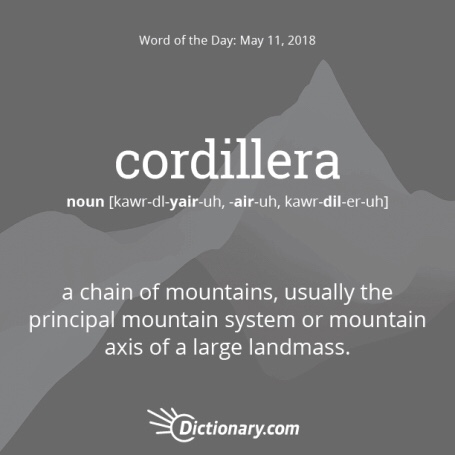
Today’s word of the day at dictionary.com is cordillera; a chain of mountains, usually the
principal mountain system or mountain axis of a large landmass; a series of parallel ranges of mountains. The word originated around 1704, from the Spanish word for “mountain chain,” from cordilla, in Old Spanish, “string, rope,” diminutive of cuerda,from Latin chorda “cord, rope” (seecord).
When I researched cordilleras, I discovered a new information source, Quora. Here is a nice summary that explains what a cordillera is and perhaps what it is not.
1. Cordillera includes a general highland formed in different periods and by different processes, for example, the cordillera of the western United States and British Columbia.
2. Mountain system refers to mountains formed in a single period and includes many mountain ranges and groups of single mountains, for example, Appalachian.
3. Mountain range refers to mountains formed in the same age and with the same process arranged in narrow and long belt, for example, Himalayan mountain range.
4. Mountain groups are highlands composed of different mountains but with a proper arrangement, for example, Juan mountain group.
5. Mountain ridges are mountains formed due to local folding and faulting and rise abruptly from the adjoining region, for example, Blue Ridge Mountains, USA.
I live in the shadow of what is defined as a “mountain ridge”. The Blue Ridge Mountains, and specifically the Roanoke Valley is part of the Appalachian “mountain system” that extends from Newfoundland and Nova Scotia in Canada to Central Alabama, which also includes the Catskills in New York, the Allegheny Highlands in Pennsylvania and The Great Smoky Mountains in Eastern Tennessee and western North Carolina. Basically it spans the Eastern portion of North America.
To find a true cordillera in North America you need to trek west to the Pacific coast to the west of The Great Basin. The Pacific Cordillera, also called Western Cordillera, the Western Cordillera of North America extends from Alaska to Central Mexico and includes three main belts: the Pacific Coast Ranges in the west, the Nevadan belt in the middle (including the Sierra Nevada), and the Laramide belt in the east (including the Rocky Mountains) extending to heights of over 20,000 feet at its highest point. This is quite a contrast to the 6,682 ft height of Mount Marshall in North Carolina in the Appalachian Mountain system.
Of course there is much more to know about Cordillera in other parts of the world, including the Andes Mountains, also known as the Cordillera de los Andes that extends over a distance of some 5,500 miles (8,900 kilometres) from the southern tip of South America to the continent’s northernmost coast on the Caribbean. They separate a narrow western coastal area from the rest of the continent and contain the highest peaks in the Western Hemisphere. The highest of them is Mount Aconcagua (22,831 feet). Other notable cordillera include: Alborz Cordillera, Northwest-Northeast Iran (also written as Elburz); Annamese Cordillera (Annamite Range), Laos and eastern Vietnam; Baetic Cordillera, Spain; East Australian Cordillera, more commonly known as the Great Dividing Range; and Zagros Cordillera, Middle East, Southeast of Turkey, Northeast of Iraq, and Northwest to Southeast Iran. From Wikipedia.
All this talk about mountains and cordillera, is making my heart race and my knees weak given my aversion to heights. But I do love the view, my feet safely planted in the valley I call home.
So, There you have it, a high level view that barely skims the apex, giving you a ‘peek’ at all things cordillera.
Here’s a Haiku to wrap this up.
cordillera cusp
grazing heaven’s canopy
air thin, vista sweet
~kat






May 12th, 2018 at 10:13 am
I’ll join you in admiring from afar!
LikeLiked by 1 person
May 12th, 2018 at 11:09 am
I don’t need to see a heaven’s-eye view…ever. 😀
LikeLiked by 1 person
May 14th, 2018 at 4:00 pm
Groovy scenes. 😎🥀😎🥀😎🥀
LikeLiked by 1 person
May 14th, 2018 at 8:22 pm
And another new word for me! 😊
LikeLike